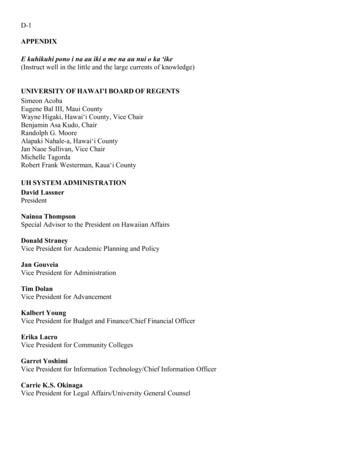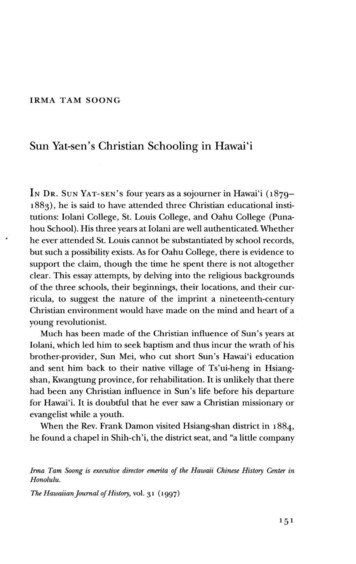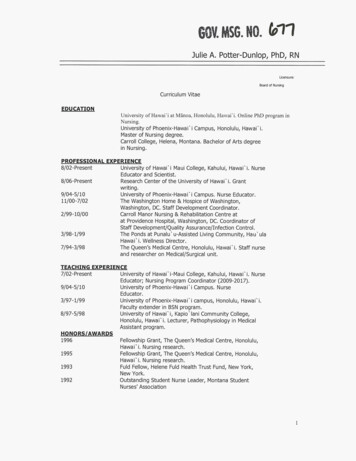
Transcription
Published for theKamehameha Schools ‘OhanaFall 2001A School for Hawai‘iRoses for the KS BandService Award HonoreesHawaiians in Alaska
Permanent Kamehameha SchoolsHawai‘i Campus Will Extend Pauahi’s Visionby Hamilton I. McCubbin, Ph.D.Chief Executive OfficerBOARD OF TRUSTEESOn June 2, 2000, amid children andchanting, and with the ÿöÿö diggingtools of our ancestors in our hands,Kamehameha students, teachers and staffunited with Hawaiÿi island parents,alumni and community members indedicating ourselves to a major expansionof Pauahi’s vision.As ÿöÿö turned the soil – and construction was begunon our third permanent Kamehameha Schools campus –the long promise of Kamehameha Schools’ commitmentto the children and families of the Hawaiÿi islandcommunity was firmly planted in the earth at Keaÿau.On Sept. 7, 2001, when opening ceremonies wereofficially held, as we once again gathered among thechildren and chanting of the people of Keaÿau, the firstphase of that long ago promise was kept.The Trustees’ decision to build permanent K-12campuses at Keaÿau and on Maui set Kamehameha on anirreversible course of building an educational system thatis second to none and designed to reach more and moreNative Hawaiians in ways never before imagined.By working with communities, our campuses willbecome focal points in increasing Kamehameha’s capacityto serve by accentuating the learning environment,maximizing facility usage, and nurturing communitycapacity for learning.We welcome and encourage our campuscommunities throughout our Kamehameha system, tounite their rich community heritage with the legacy of ourPrincess, so that together we may serve more and morepeople of Hawaiian ancestry through education.Robert K. U. Kihune ’55ChairmanJ. Douglas Ing ’62Constance H. LauDiane J. PlottsNainoa ThompsonCHIEF EXECUTIVE OFFICERHamilton I. McCubbin Ph.D. ’59CHIEF EXECUTIVESDudley Hare Jr., Ed.D.Chief Education OfficerWendell F. Brooks Jr.Chief Investment OfficerGerald MoriharaChief Administrative OfficerColleen I. Wong ’75Chief Legal OfficerEric K. YeamanChief Financial OfficerEDUCATION GROUPD. Rodney Chamberlain, Ed.D.Headmaster-Maui CampusMichael J. Chun, Ph.D. ’61Headmaster-O‘ahu CampusStan Fortuna Jr., Ed.D.Headmaster-Hawai‘i CampusJuvenna Chang, Ed.D. ’60Dean-Extension EducationSuzanne RamosDean-Early Childhood EducationI Mua Kamehameha!I MUA STAFFVol. 2001, Issue 3I Mua is published quarterlyby the KamehamehaSchools CommunicationsDivision, 567 S. King St.#301, Honolulu, HI 96813.I Mua exists to informalumni, parents, studentsand friends of KamehamehaSchools of current educational and endowmentprograms, to generateinterest in and support forthose programs, and tohelp alumni maintain closeties to the institution andto each other.Change of AddressKamehameha Schools alumniwho have a change ofaddress please notify theAlumni Development Office at567 South King Street, Suite190, Honolulu, HI 96813,e-mail: alumni@ksbe.edu,fax 808-534-3890 or call808-534-3939.SubmissionsIf you’ve got a story ideaor a comment for us, pleasewrite to I Mua Editor,Kamehameha Schools,1887 Makuakāne Street,Honolulu, HI, 96817-1887or e-mail imua@ksbe.edu.Lesley Agard ’68Executive EditorEd Kalama ’76Editor8Gerry Johansen ’60Alumni EditorMichael YoungPhotographyCONTRIBUTORSMarsha Bolson ’70Ellen KazamaLurline Naone Salvador ’69Ellen PelisseroMichelle YamaguchiI MUA DESIGNO Communications2
Published for the Kamehameha Schools ‘Ohana4A School for Hawai‘iKamehameha Schools unveils the first phase of its planned 200 million, 300-acre Hawaiÿi campus.8Roses for the KS BandAfter celebrating the 25th anniversary of the Tournament of Bands,the Kamehameha Schools Warrior Marching Band and Color Guardis heading for the Rose Bowl Parade.12High School Style13Hawaiians in Alaska16244Coordinated attire is expected to help keep the focus on educationat Kamehameha Schools.As part of an exchange program involving the Bishop Museum,members of the Kamehameha Schools ÿohana experience the cultureof Native Alaskans.Departments18KS in the NewsService Awards21Life at KamehamehaKamehameha Schools honors its 2001 Service Award Honorees.32Alumni Class NewsAlumni Week 200138College Close-Up40Milestones43Regional Alumni Associations48I Remember WhenClass representatives offer their take on Alumni Week festivities.Cover StoryThe Kamehameha Schools HawaiÿiCampus now serves 144 students ingrades six through eight.103
TechBldg. #15Future CommunityOutreach Bldg.FutureK-5SpecialtyK-5 ClassroomK-5ClassroomK-5SpecialtyPlay -8Admin.6-8SpecialtyExistingPhase 16-8ClassroomK-8Library6-8 MusicPlay Field6-8Gym6-8ClassroomFutureChapelFuture mitoriesGymnasiumHigh SchoolAthletic FieldsCafeteriaKamehameha SchoolsHawaiÿi CampusThe Kamehameha Schools Hawai‘i Campus is expected to have an enrollment of 1,120 students by 2005.4
A Schoolfor Hawai‘iKamehameha Schools unveils the first phase of itsplanned 200 million, 300-acre Hawaiÿi campusAnother chapter in the growing legacy of Princess BernicePauahi Bishop was written in August when 144 studentsof Hawaiian ancestry took their places on a permanentKamehameha Schools campus on the island of Hawaiÿi.Located roughly seven miles south of Hilo, in Keaÿau just offthe Volcano Highway, Kamehameha Schools Hawaiÿi Campus nowserves students in grades six through eight.The completed 30 million, 15-acre first phase of a plannedfive-stage development houses the first two buildings of the middleschool. Phase I includes six standard classrooms, two specialtyscience rooms, a teacher planning center, an art and ceramics lab,teen health center, industrial arts drafting lab, computer lab andfacilities for Hawaiian cultural and language studies.Hawaiÿi Headmaster Stan Fortuna said reaction to the facilitieshas been tremendous. “The community is thrilled with the school.It’s so special and so close to the heart of literally thousands ofpeople,” he said.“The response from the community has been very positive,”added Vice-Principal Eva Bogue. “I think there’s great respect forKamehameha Schools and the people here are very happy we’re apart of their community.” HAWAI‘I“I’ve had a chance to oversee morethan 100 million in schoolconstruction during my career, andI can very honestly say that I havenever seen such wonderful facilitiesfor children.”– S TA N F O R T U N A5KEA‘AU
“I think there’s great respectfor Kamehameha Schoolsand the people here arevery happy we’re a part oftheir community.”– E VA B O G U EThe campus has a spacious, airy feel about itwhich Kamehameha Schools architect PeterUchiyama describes as Hilo plantation style. “Weactually went through a process to develop thestyle – be it contemporary, Hawaiian or whateverit was going to be,” Uchiyama said.“The original architect, AM Partners, developed what we called a Hilo contemporary, orHilo style, which is similar to a plantation style. Ituses the local vernacular – the building types andbuilding materials – to develop the appearance.”Temporary classroom facilities, opened inKeaukaha in 1996, continue to house 128 elementary school students under the supervision ofPrincipal Barbara Robertson.But with phase two of the campus scheduledfor completion in August 2002, the next schoolyear is expected to see enrollment reach 688kindergarten through grade nine students at theKamehameha Schools Hawaiÿi Campus.Phase II construction, now underway withan estimated cost of 65 million, will completeboth middle and elementary school facilities.6Phase II includes two K-5 classroom buildings, aK-5 specialty building, K-8 cafeteria, K-8administration building and middle schoolgymnasium and library facilities.In addition, a portion of the 53 millionthird phase of the development, scheduled tobegin in January 2002, will be completed byAugust 2002 to allow for students entering ninthgrade next fall.This third phase that includes the highschool portion of the campus is scheduled forcompletion in August 2003. Phase III includesthree classroom buildings, a swimming pool, thehigh school gymnasium, a football/track field,and baseball, soccer and softball fields.Three more high school classroom buildings,a high school cafeteria and media center willhighlight phase four of the project while a campusadministration center, chapel, performing artscenter, music facility, tennis courts and a riflerange are slated for the final phase, anticipatedby 2005.“Everything is still fairly fluid at thispoint,” Uchiyama said. “Some buildings maycome in earlier than scheduled. It’s just hard totell right now.”Fortuna, a former school superintendentfrom Michigan, assumed his duties in July. “I’mvery, very excited about what I’ve seen to thispoint,” he said. “I’ve had a chance to overseemore than 100 million in school constructionduring my career, and I can very honestly saythat I have never seen such wonderful facilitiesfor children.”
Robertson, who has supervised the island’stemporary school campus since being namedprincipal in 1996, said she was happy to seeFortuna come aboard.“I think we’ve made a good decision withStan,” she said. “He’s eager to learn, easy to talkto, he has a nice sense of humor and he’s verymuch interested in people – children andteachers.”“Stan’s been wonderful to work with,”added Bogue, who earlier in her career teamedwith Robertson to help establish a Kona campusfor Hawaiÿi Prep. “He, Barbara and I really feellike a team. He’s very supportive and I think he’llbe a real strong leader for us.”Robertson said no group has shown moreappreciation for the new school than parents.“As I meet our parents, they are just so happy,”she said. “It’s not unusual for them to come upand hug me and tell me how thankful they arefor the new middle school and how delightedthey are that their children don’t have to goaway anymore to attend Kamehameha.“This has been a long journey for me. It’skind of overwhelming, but the reality is setting inthat what we’ve all been working for all theseyears is really here.”The uniqueness of the island of Hawaiÿi isexpected to open opportunities for Kamehamehastudents in the fields of aquaculture, astronomy,agriculture and tourism, to name a few.“It’s kind of overwhelming,but the reality is setting inthat what we’ve all beenworking for all these yearsis really here.”– BARBARA ROBERTSON“There are other areas, too, like thevolcanoes and marine biology, that are for themost part specific to this island,” Fortuna said.“That is a huge advantage to providing directeducation services on this island because there isso much here to take advantage of. Our childrencan someday be leaders in these areas.”“The uniqueness of this island is really itsresources,” Robertson said. “Resources in thesciences, resources in the ocean and resources inHawaiian culture and language. I think it’s allpart of what our school stands for – it’seducation not only in the narrow view, buteducation in a very broad sense.”Although the school is being built for aneventual enrollment of 1,120 kindergartenthrough grade 12 students by the 2005-2006school year, Uchiyama said the campus has beenplanned for eventual expansion should trusteesdecide to do so.“It’s all been planned where we can just adda few buildings and double the enrollment,” hesaid. “It’s going to be a very, very nice school.”7
ROSES FOR THE KS BANDAfter celebrating the 25th anniversary of the Tournament of Bands, the KamehamehaSchools Warrior Marching Band and Color Guard is heading for the Rose Bowl Parade“It’s the bestparade in theUnited States.”– JOHN RIGGLEven though they’ve played to worldwideacclaim in Switzerland, Austria, France,Germany, Italy, England, Monaco and acrossthe continental United States, there’s still one performance that holds special meaning for theKamehameha Schools Warrior Marching Band andColor Guard.And that’s the Rose Bowl Parade.Considered the “granddaddy” of all parades,the KS Band will make its third appearance in thelast 25 years in the Tournament of Roses Parade inPasadena, Calif., on Jan. 1, 2002.Band Director John Riggle couldn’t be happier.“You have to have a program that’s worthy,”E8Riggle said. “They only take 20 bands fromaround the world, so it’s kind of a narrow process.It’s the best parade in the United States.”Named by the National Band Associationas one the Top Ten Marching Bands in the UnitedStates in 1980 and winners of the Mililani HighSchool BandFest the last nine years running(signifying the top band in Hawaiÿi), theKamehameha band has proven its worth locally,nationally and internationally.In 2000, they were the only band in theUnited States to have the distinct honor to receivean invitation to perform at the Royal Palace ofMonaco.
The KS Band will precede its Rose BowlParade appearance with a performance in the SanDiego Chargers halftime show Dec. 30. In order tosecure a spot in Pasadena, Riggle said he sent inaudio and video tapes, pictures of the group andnewspaper clips.“You have to apply, and hundreds maybethousands of bands apply,” Riggle said. “Then, aselection committee names the bands two years inadvance in order to allow time for fundraising forthe trip. We try to go when it means something.”The significance to Kamehameha this yearis the 25th anniversary of the Tournament ofBands, a festival hosted annually by the Warriorsand begun during Riggle’s first year with theschool in 1976.The festival provides a means to assembleHawaiÿi’s high school marching bands for interaction and exposure to the latest trends, promotesmarching bands as a creative art form and helpsto substantiate the idea that a marching band is aworthy vehicle for music education.Typically, 13-15 public and private schoolbands participate. This year’s festival is set forNov. 17.Although the tournament is a “competition,”scores are not announced to the public – thefestival is seen as a way to help bands improvethemselves.“It’s a different type of competition,” Rigglesaid. “Every band strives to do its best out there,and they are judged and evaluated by professional judges that we bring in. But it’s not like first,second or third is the whole object.“The tournament gives the bands recognitionand gives students something to work toward. Afestival, or a competition – just like with athletics– gives a band something to strive for and attain.”Riggle said a combination of forces have ledto Kamehameha’s peerless excellence as amarching band and color guard.“We’re lucky to have all three pieces of whatwe call ‘the pie’ at work here at Kamehameha,”Riggle said.9
“Arts and cultureare well-respectedand encouragedhere”KS BANDPERFORMANCE HIGHLIGHTS– JOHN RIGGLEON KAMEHAMEHASCHOOLS102002Tournament of Roses Parade2001San Diego Chargers Halftime2000Royal Palace of Monaco1997Sugar Bowl Halftime1996Baltimore Ravens Halftime1994London New Years Day Parade1993San Francisco 49ers Halftime1993President Clinton Inaugural Parade1991Orange Bowl Parade1989Tournament of Roses Parade1987Royal Tournament in London1984Fiesta Bowl Parade1982Portland Rose Festival Parade“We have an outstanding parent group –our booster club is just amazing. They supportthe kids and they are involved in every facet ofour program.“Second, is the school administration. A lotof schools, the first thing they cut out is music.They can’t afford it, or they think it’s tooexpensive.“Here, the administration says, ‘Yes, music isvaluable and we want the kids to learn music as apart of the core curriculum at Kamehameha.’That’s a strong influence and it’s very unusual.Arts and culture are well-respected andencouraged here.“The third part is the kids. They want towork and succeed. Our kids, there’s justsomething about them. They have this bond aboutworking together. They don’t like to be singledout, but as a group they tend to work togetherbeautifully. And that’s the whole band function –it’s not ‘me,’ it’s ‘we’ – always.“Our kids really work hard as a group, andthe experience is really a valuable lesson for them.They never come to class not wanting to excel.They’re always ‘What can we do to get better?’“It’s just a wonderful way to teach.”
LEADER OF THE BANDAs he marks his 25th year with Kamehameha Schools,Band Director John Riggle has discovered the true meaning of manahe first time he took in Kamehameha’s O‘ahuCampus, a job-hunting John Riggle wasimpressed. Almost too impressed.“I came here and looked at the campus and toldmyself ‘No way.’ I didn’t even have a master’s degree,and I figured this was way above me. I knew I was agood teacher, but I thought I could never keep upwith what I saw here.”Since 1976, Riggle has kept up enough to lead theWarrior Marching Band to international acclaim and aplace alongside the top high school bands in thenation.Riggle is a former professional drummer whoused the sticks to pound his way through San JoseState. For him, working his way through school meantplaying rock, jazz and country and western five to sixnights a week.Riggle combines the laid back temperament of amusician with the intensity of a top-flight teacher, andthe combination is one Kamehameha students havefound immensely appealing.“He’s a father, an uncle, an instructor, a counselor,a babysitter and a friend to these kids, and not in anyorder” said AristotleSanta Cruz, the assistant band director atKamehameha since1978. “He just has away of relating at manydifferent levels.”It’s easy to seethat Riggle has a specialfondness for hisstudents. “It neverceases to amaze mehow much the kids canaccomplish,” he said.T“There is an ‘X’ factor here. People say there’s a‘Hawaiian mystique’ about performing arts and thatthese kids have this ‘thing’ about them. And they do.“We step back and watch the show when thesekids are under pressure in a concert or a competition,and for some reason it just goes up a notch. You can’tfigure out how that happens. They have this magic.“When they’re done, you can see it in their facesand you can just feel it. It’s mana. It’s real mana and it’ssomething unique.“I’ve worked with other bands and they don’tever get that extra bond. It’s that Hawaiian thing andthere really is such a thing.“It’s been a fabulous experience for me.”“He’s a father, an uncle,an instructor, a counselor, a babysitterand a friend to these kids.”– ARISTOTLE SANTA CRUZ11
HIGH SCHOOL STYLECoordinated attire is expected to help keep the focus on education at Kamehameha SchoolsT“Kamehamehahas had a longtradition ofstudentsbeing properlydressed forschool.”– TONY RAMOShey may not be the starched-stiff ROTCuniforms of years past, but Kamehamehahigh school students are sporting a new“coordinated attire” look this fall.Boys have a choice of polo shirts in threedifferent colors or an aloha shirt and shorts ortrousers. Girls can choose from two polo shirts,shorts and slacks or aloha attire in either a longdress or short dress and blouse.“The decision to go to uniforms was relatedto wanting to take the focus off of dress codeenforcement issues,” said Julian Ako ’61, Dean ofStudent Activities. “We felt that teachers andadministrators were having to focus too much ondress code violations, and that distracted us fromfocusing on the education of our students.”Ako admitted that the school faced somedifficulties implementing the program this fall andoffered his apologies to parents. “I acknowledgein a very, very empathetic and sympathetic waythat there were challenges and frustrations forparents when they went to Liberty House andfound items they wanted were not available,”he said.“This first year, I think, was bound to be achallenge because of the sheer numbers involvedin implementation – we were outfitting 1800students and had to bring in 28,700 pieces ofclothing. In future years, the numbers are goingto be less.”A special committee comprised of parents,12students and staff helped select the attire,including the aloha print clothing which wasmanufactured under an exclusive Kamehamehalabel and designed by school illustrator/designerRobin Racoma.“The design depicts a kukui leaf/nut lei,”Racoma said. “Kukui was used because of itssymbolic significance to knowledge and learning.”“Kamehameha has had a long tradition ofstudents being properly dressed for school,although girls haven’t been in a uniform or coordinated attire for as long as I can recall and thatgoes back at least 50 years,” said Kamehamehahigh school Principal Tony Ramos ’58.“In recent years, with the changing societalmores and designer apparel, it has become muchmore difficult to maintain a dress standard –especially with the girls,” Ramos added.“We have always expected our studentsto dress for the ‘business of school’ and not forthe beach or a party. The coordinated attire thisyear is an effort to standardize these expectationswith the least amount of staff and student timespent in this endeavor.”Ramos had words of appreciation forparents and students. “We do want to thank allof our parents and students for their patience andunderstanding as we go through this time oftransition. We realize that without their support,we could not implement this new component toour program.”
Hawaiians inAlaskaAs part of an exchange program involving theBishop Museum, members of the Kamehameha Schoolsÿohana experience the culture of Native AlaskansSince March of 2000, the Bernice PauahiBishop Museum and Kamehameha Schoolshave been working together to revive astudent volunteer program called the MuseumWorkshop.The program, originally created byKamehameha Schools teacher Dr. Donald Mitchelland Bishop Museum director Dr. AlexanderSpoehr, was conducted at the museum from 1952through 1964.Students who participated in the programworked on carpentry projects, classified insects,acted as tour guides, and provided a variety ofother services for the museum. Current BishopMuseum Education Specialist Kealoha Kelekolio’65 participated in the workshop in 1963.The purpose of the student volunteer trainingprogram is to teach Kamehameha students tointerpret Hawaiian culture while introducingthem to the array of academic and professionaloccupations that are required for the operationof the museum.In March of 2001, Mehana Ka‘iama ’01,Robert Baptiste III ’01, Brandi Galdeira ’01,Rachel Akau ’02, Sarah Kaopuiki ’03 andAlexander Baltazar-Quizon ’04 completed thetraining program and volunteered at the museumin April and May.In June, Ka‘iama, Baptiste and BaltazarQuizon traveled to Anchorage, Homer andNanwalek to participate in the Bishop Musuem’sAlaska Cultural Exchange.Also making the trip were KealohaKelekolio ’65, Kawika Makanani ’66, ShirleyYojo Swinney ’67 and Guy Kaulukukui ’78.Kaÿiama and Baptiste share their experienceswith Native Alaskans in the following essays.Between Native Peoplesby Mehana Ka‘iama ’01On June 12, 2001 a group of sixteen küpuna, mäkua,and ‘öpio traveled to Alaska to embark on acultural exchange.For me, the trip was an opportunity to learnmore about my Hawaiian culture and about theNative Alaskan culture.Preparation for the trip included late nightchant and hula practices, song memorizing andlearning protocol, as well as assembling costumes.We also participated in making and collectingof gifts to present to the people of Alaska. Theseincluded a number of Hawaiian flutes made outof bamboo, games for the children to play madefrom the midribs of coconut leaves and husk,t-shirts detailing a chant regarding the searchfor ‘awa, and various Hawaiian foods such as poi,kūlolo and laulau, which were taken up to Alaskaand presented to the natives.13
From left, Alexander Baltazar-Quizon, Robert Baptiste III andMehana Ka‘iama are joined by Kumu Kawika Makanani ’66 at theNative Alaskan Heritage Center.We arrived in Alaska on the morning of June13th, and headed to the Native Alaskan HeritageCenter. Although I had not slept at all on theplane and my head and body were sore withfatigue, the center inspired and revived me. It wastruly inspirational to see so many people workingtogether in efforts to practice their culture andeducate outsiders.At the Heritage Center there were children,teenagers, adults and elders dancing and teaching.The beautiful mixture of Athabascans, Inupiaqs,Aleuts, Yup’iks and Tlingits made the centerextremely appealing to me. Indigenous peopleproud of their own culture is a beautiful thing! Itmade me realize that Hawaiians are not alone.You hear about the struggles that othercultures endure and how they live and work, butuntil you see it first hand you can’t really appreciate and realize the similarities.Like Hawaiians, Alaskans dance to tellstories, they embrace the family unit, they enjoyeating various seafoods and they have enduredsimilar oppression in their homeland. And theyare making a huge effort to hold on to their culture.I never realized how rich in culture Alaskawas until I took the trip and I believe that whenpeople come to Hawaiÿi, knowing very little aboutour history, they also feel this way.My experiences at the Heritage Center haveforever given me a new outlook on Alaska. Now,Alaska is not just a name of another place, but acousin land to Hawai‘i. A place where similaritesconnect us and differences educate us.It is wonderful to know that indigenouspeople all over the world are proud of theirculture and not afraid to practice and love it.Visiting a Native Alaskan Villageby Robert Baptiste III ’01The expansive Pacific Ocean reaches many shores.The waters that embrace Hawai‘i’s sands are thesame waters that caress the shores of Nanwalek,Alaska.This summer, natives of these lands unitedas one.I was awed by the majestic mountains andglassy water as our boats pulled into the bay.Buildings were few – Nanwalek’s population isunder 200.On shore, we met our Alutiiq “cousins,” thenatives of Nanwalek, and asked permission toenter their land by chanting an oli kähea.The Alutiiq responded with song and danceof their own culture.Indigenous people proudof their own cultureis a beautiful thing!– Mehana Ka‘iama14
In doing so, the Alutiiq showed their love andrespect for us, because they were honoring not onlyus, but also our küpuna who came before.Although we were on a sort of vacation, thepeople of Nanwalek were not. But they went outof their way to make time for us, and to welcomeus with no reservations. We were welcomed asfamily into their homes with generosity andselflessness.We enjoyed a feast that blended Hawaiianand Alaskan food and were served delicacies suchas frybread, salmon eggs, mukluk (whale) andsalmon served in various dishes.Each member of our group brought their ownmaterial makana for our cousins, and things rangedfrom lei hulu, pa‘akai, and even things like t-shirts.Representatives from the museum had alsobrought some makana up for exchange, like an‘umeke and a kōkō, and also kı̄hei that was given toEmilie Swenning, chief of Nanwalek.In return, we received commemorationt-shirts with graphics designed by Nancy Radke,a native artist of Nanwalek, jewelry, and evenEagle feathers, which in Alaska, can only beowned by natives. We also received native fibers,salmon skin, and shells from Nanwalek.“Talking story” with my Alutiiq peers helpedme recognize the similarities of our people. Weshare the same love for the land and love for ourancestors.Although called Alutiiq nowadays, theytraditionally called themselves Sugpiaq. Similarly,Hawaiian is also a new ethnic identification, asour ancestors called themselves kānaka maoli.In each of our languages, these words mean“Talking story” with myAlutiiq peers helped me recognizethe similarities of our people.– Robert Baptiste III“real people.” And as real people, we becameeach other’s best teachers.Another traveler, Kamalu DuPreez-Aiavao,and myself had grown so close with Aunty Bettyand her family that we were offered hideaway inher home in case we didn’t want to leave, andwere also given an open invitation to return tovisit them at anytime.Leaving the village was less difficult knowing my family had grown to include the peopleof Nanwalek. My last view of Nanwalek wasSparry Ash and Aunty Betty dancing from theshore, wishing us a safe return.Back in Hawai‘i, the Pacific continues toconnect me to Nanwalek and my family acrossthe ocean.Kamehameha student volunteers enjoythe beauty of Nanwalek. From left,Mehana Ka‘iama, Alexander BaltazarQuizon and Robert Baptiste III.15
Service Awards ahalo a Nui Loa to the following Kamehameha Schools employees for their years of dedicated servicetoward fulfilling the vision of Ke Ali‘i Bernice Pauahi Bishop.45 YEARS OF SERVICE40 YEARS OF SERVICEBeatrice CanarioLewis Hubbard35 YEARS OF SERVICEMary CarvalhoSarah KeahiGary Obrecht16Momi MaunakeaDonna OrrJudy NanioleHerman Saniatan
20 Years of Service30 YEARS OF SERVICEElizabethArquetteHalawe BohreerDonald HarveyRosaline DooRuby LoweGail Woliver25 YEARS OF SERVICEJoyce Ahuna-KaaiaiBryant AsaoMarsha BolsonErnestine BrennonBlossom BurdettDoyal DavisPatricia GillespieP. Denise JohnsonHiram Kaikaina Jr.Wendel KamJanis KaneA. Pua KangMoana LaneMoana LeongLollita MartinesAlice MatsukawaRosanna MatsuyamaHeather MaughanAnnette PaganEstrella PeraltaWendell PihoEugenia StenderEditha TalioagaDiane Tanner-CazinhaAlbertha TavaresCarolyn WatadaLeslie YoungVelma Young15 Years of ServiceGail AokiJean CacholaWayneChangWendellDavisF. KaheleKukeaVivian LittleMichaelMiyakeEli NahuluAnnetteOkimotoRonald ToddMahina Ah YuenOakleigh AkakaJennifer AndersonPraxedes BilogJoyce BowerLana CarrollDavid ChungReggie CoatsLynn DeMelloJeanette DuranteRose EnosSharmaine EnosL. Pua Fernandez-AkamineEloise HaakeRobert HamiltonPaula Hartley-ForsythRonald HirataCharlene HoeDeborah HoopaiGail IshimotoLinda JacobsKeala KaupuCarol KozaLeonard Kwan Jr.Judy LayfieldJanice LumDiane MaherTeresa MakuakaneDrechselSheree MendonsaDonna NakaharaGuy NishimuraRichard RapozaRonald SamoriRobert Stender Sr.Cheryl SueyoshiWanette TanakaAnjanette Thomas ChangKimberly ThomasLehua UahinuiDominador UlepLiane VierraKaren WilkinsonSusan W
4 A School for Hawai'i Kamehameha Schools unveils the first phase of its planned 200 million, 300-acre Hawaiÿi campus. 8 Roses for the KS Band After celebrating the 25th anniversary of the Tournament of Bands, the Kamehameha Schools Warrior Marching Band and Color Guard is heading for the Rose Bowl Parade. 12 High School Style











